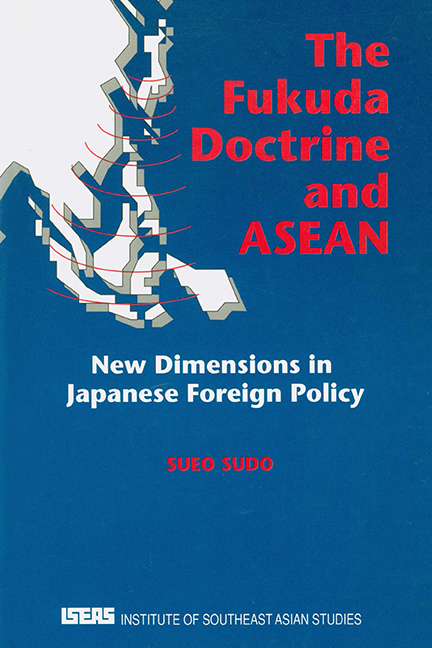Book contents
- Frontmatter
- Dedication
- Contents
- List of Tables
- Preface
- Abbreviations
- Introduction
- chapter one A Framework for Analysing Japanese Policy Towards Southeast Asia
- chapter two Post-war Japan's Re-entry into Southeast Asia
- chapter three Japan's Policy Towards Regional Development
- chapter four External Challenge and Changing Japan-Southeast Asia Relations; 1975–77
- chapter five A Changing Southeast Asia in Japanese Politics
- chapter six Formulating the First Doctrine in Japanese Foreign Policy
- chapter seven Japan's ASEAN Policy, 1977–87
- chapter eight Conclusion
- Appendices
- Bibliography
- Index
- THE AUTHOR
chapter eight - Conclusion
Published online by Cambridge University Press: 21 October 2015
- Frontmatter
- Dedication
- Contents
- List of Tables
- Preface
- Abbreviations
- Introduction
- chapter one A Framework for Analysing Japanese Policy Towards Southeast Asia
- chapter two Post-war Japan's Re-entry into Southeast Asia
- chapter three Japan's Policy Towards Regional Development
- chapter four External Challenge and Changing Japan-Southeast Asia Relations; 1975–77
- chapter five A Changing Southeast Asia in Japanese Politics
- chapter six Formulating the First Doctrine in Japanese Foreign Policy
- chapter seven Japan's ASEAN Policy, 1977–87
- chapter eight Conclusion
- Appendices
- Bibliography
- Index
- THE AUTHOR
Summary
In the introduction to this book, it was argued that the period 1975–80 formed a particularly significant phase in Japan–Southeast Asia relations. It was during this period that Japan underwent a shift from economic to political diplomacy towards the region, exemplified by the Fukuda Doctrine. Theoretically we have attempted to explain causal relations between four independent factors and the policy shift. Having analysed the process of forging the Doctrine and the Japanese Government's implementation of it, let us recount how and why Japan's active foreign policy has been put into motion. In so doing, the two periods of Japan–Southeast Asia relations and the implications of this study will be summarized. Based on the conclusions derived from this case study we will then discuss briefly the future prospects of Japan–Southeast Asia relations.
THE PRE-DOCTRINE PERIOD
During the first period, 1951–4, Japan's so-called “economic” foreign policy had been vigorously carried out by relying upon the U.S. security networks in Asia. The triangular relationship among the United States, Japan, and the countries of Southeast Asia was the key to Japan's encroachment on the Southeast Asian economies. The process of decision-making; although slightly different in the case of the Asian Development Bank, was characterized by the pattern of a tripartite alliance between the ruling party the business community and the concerned bureaucracies. More important was the fact that Japan was designated as the superdomino, or workshop, of Asia in U.S. cold war strategy which was basically retained until 1974.
Secondly the pursuit of Japan's economic diplomacy had a direct bearing on the three assumptions discussed earlier: American military protection and its reliable commitments in Asia; free access to raw materials and export markets in order to accelerate the Japanese economy; and a stable political framework in which a dominant LDP can pursue a consistent foreign policy There was little doubt that the ruling party that is, the LDP, took every effort throughout the first period to preserve the three assumptions as the philosophy of main-stream conservatism (Hoshu Honryu).
- Type
- Chapter
- Information
- The Fukuda Doctrine and ASEANNew Dimensions in Japanese Foreign Policy, pp. 226 - 240Publisher: ISEAS–Yusof Ishak InstitutePrint publication year: 1992

